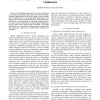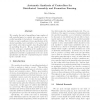3955 search results - page 66 / 791 » Comparing the Power of Robots |
ICAS
2009
IEEE
15 years 1 months ago
2009
IEEE
As long as computers continue to get more CPU processing power, data centers need to optimize their power usage. We can do this and maintain the same complexity level as before by...
CEC
2009
IEEE
15 years 4 months ago
2009
IEEE
— Legged robots show promise for complex mobility tasks, such as navigating rough terrain, but the design of their control software is both challenging and laborious. Traditional...
PROMISE
2010
14 years 4 months ago
2010
Background: Defects are related to failures and they do not have much power for indicating a higher quality or a better system above the baseline that the end-users expect. Nevert...
IROS
2009
IEEE
15 years 4 months ago
2009
IEEE
— Hybrid deliberative-reactive control architectures are a popular and effective approach to the control of robotic navigation applications. However, the design of said architect...
ICRA
2002
IEEE
15 years 2 months ago
2002
IEEE
We consider the task of assembling a large number of self controlled parts (or robots) into copies of a prescribed assembly (or formation). In particular, we introduce a way to sy...


